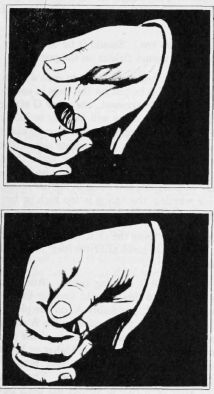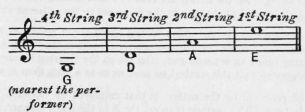Mandolin Self Instructor, online tutorial - Page 13
A simplified self learning system for the Mandolin with tuning instruction, song folio, chord diagrams, sheet music and PDF for printing. By ZARH MYRON BICKFORD
| Share page | Visit Us On FB |
|
THE PICK AND HOW TO HOLD IT |
|||
 |
The pick or plectrum is very properly called the tongue of the mandolin, and its selection and the manner
of holding it should receive careful attention. In France the pick is called a plume and in Italy a penna, from the fact that some of the earliest picks were
made from feather quills, somewhat resembling the old quill pens. Picks are made from a variety of materials, but best results will be obtained from celluloid, hard rubber or composition and tortoise shell. There are even more shapes and sizes than materials, used, but for general purposes the author of this work has found that a pick shaped like the subjoined diagram and of medium thickness, gives the best results. For heavy or forceful playing a very hard and thick pick is best, but
it is seldom advisable, under any circumstances, to use an extremely flexible pick. It is held by first partially closing the hand, as shown in the cut oppo- site, after which the pick is placed on the side of the first finger, at the first joint, with the point of the pick away from the hand and pointing nearly at right angles from the tip of the finger. It should be placed far enough over the finger so that about a quarter
of an inch projects beyond the nail. The thumb is then brought down so that the ball or fleshy hump, ex-
actly midway between the end and the first joint, touches the flat surface of the pick, thus holding it securely in position. The thumb joint, like that of the left hand, is kept in a straight, though not a strained position, while the remaining three fingers are held slightly separated and in exactly the manner shown in the second cut. The second joints of the first two fingers are sepa- rated slightly more than the rest, but the first joint of the second finger is curved sharply so that this finger crosses the first finger in such a manner that the bases of the nails are exactly in a line with each other and the corners nearly touch. The third and fourth fingers then fall into line in an easy and graceful manner, the little finger being a little farther out or more open than the others. A careful examination of the second cut will illustrate all these points, the importance of which cannot be overestimated. When the pick and arm are held in the manner described, the point
of the pick, when resting against the strings, will be found to point slightly toward the fingerboard from a perpendicular position. This slant must be very slight, however.  |
||
|
TUNING THE MANDOLIN |
|||
|
Since the instrument must be put in tune before it can be played upon, it is important that the ear be trained from
the first to recognize both when it is out of tune, and what is of even greater importance, when it is in tune. Each pair of strings must be made to sound exactly alike, or in unison, the unison strings always being spoken of as a single string. The following illustration shows the notes represented by the four open strings and to which they must be tuned. |
|||
 |
|||
|
The G to which the fourth string is tuned is the first G below Middle C on the piano, the D that immediately above this C and the A and E each a fifth higher, in succession. |
|||